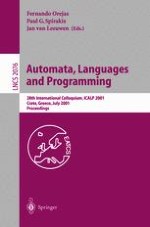2001 | Buch
Automata, Languages and Programming
28th International Colloquium, ICALP 2001 Crete, Greece, July 8–12, 2001 Proceedings
herausgegeben von: Fernando Orejas, Paul G. Spirakis, Jan van Leeuwen
Verlag: Springer Berlin Heidelberg
Buchreihe : Lecture Notes in Computer Science
Enthalten in: Professional Book Archive
